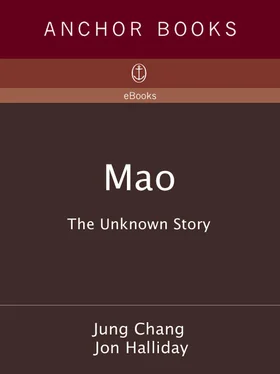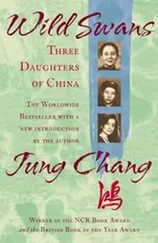In order to make sure that the Reds followed the route he had mapped out, and to rule out any change in their instructions, Chiang decided the eve of the Reds’ departure was the moment to cash in a huge intelligence coup. In June the Nationalists had covertly raided the CCP’s Shanghai radio station, which had been the link between Ruijin and Moscow. For several months, the Nationalists kept the station operating under their control, and then in October they shut it down altogether. The CCP tried to re-establish a link by sending a top radio operator to Shanghai, but he defected as soon as he arrived. Assassins were sent after him. They missed the first time, but managed to kill him in his bed in a German hospital at the second attempt. From now on, Shanghai became largely irrelevant to the CCP, although it remained an important base for Moscow’s secret services.
THE LONG MARCH was used by Chiang to initiate his Reds-for-son swap. Just before the breakout from the Ruijin base, he sent a request through diplomatic channels asking for his son to be returned. On 2 September 1934 he recorded in his diary that “a formal representation has been made about getting Ching-kuo home.” During the crucial period of the breakout in October — November, Chiang found a way of emphatically telling the Russians he was closing his eyes and letting the Reds go, by not merely absenting himself from the front line, but heading off a thousand kilometers in the opposite direction for a very long forty-day public tour of North China.
Moscow understood the message. During the precise period between Chiang requesting his son’s release and the day Mao and Co. crossed the Xiang River and were free of Chiang’s blockhouses, Moscow dramatically increased surveillance of its hostage. Ching-kuo, who had previously worked in a village and a Siberian gold mine, was now working in a machinery plant in the Urals. Then, as he later recounted, “from August to November 1934, I was suddenly … placed under the close surveillance of the Russian NKVD [KGB]. Every day I was shadowed by two men.”
At the beginning of December, just after the Chinese Reds walked past the last blockhouses, Chiang asked for his son again (as the KGB informed Ching-kuo). But the Russians told Chiang that his son did not wish to return. “There is no end to the Russian enemy’s revolting deceit,” Chiang wrote in his diary, although he said he could “cope with it calmly.”
“I feel I have indeed made progress since I can even shrug off this family calamity.” Chiang knew his son would be safe — if he did more for the Reds.
Of the other half (amounting to some 40,000), who did not make it past the river, “over 3,000” were killed at the Xiang. The rest were either scattered at the Xiang, or had perished during the preceding six weeks’ trek from illness or exhaustion, or had been casualties of small skirmishes, or had deserted.
She was the sister of Mme Chiang Kai-shek. The fact that she was a Russian agent remained a secret throughout her long life, and remains little-known to this day. But a secret letter she wrote on 26 January 1937 to Wang Ming, the head of the CCP delegation in Moscow, and her controller, shows her role beyond any doubt. The letter opens: “To Comrade Wang Ming. Dear Comrade: It is necessary for me to inform you the following facts since they may endanger my activities … in China in the near future. I place them before your consideration in the hope that you will advise me as to what course to pursue …” One of the points in her letter was complaints about the American Comintern agent Agnes Smedley, who, Mme Sun said, brought “foreign sympathizers home, with the result that this special house which has been used for important purposes now has been ruined … I forwarded your instructions to isolate her” to the CCP.
The Nationalist army commander in Shaanxi was a fellow traveler called General Yang Hu-cheng, who had earlier asked to join the Communist Party, and whose relationship to the Reds was known to Chiang. He collaborated well with Shao.
13. LONG MARCH II: THE POWER BEHIND THE THRONE (1934–35 AGE 40–41)
BY MID-DECEMBER, Chiang had steered the Long March into Guizhou, the first province he wanted to bring under control. As he had foreseen, the arrival of a Red Army 40,000 strong threw the local warlord into a panic. Chiang “has long wanted to take over Guizhou,” the warlord recalled feeling at the time. “Now, the Central Government Army is coming hot on the heels of the Red Army, and I could not possibly turn him down … I was really in turmoil. Under the circumstances, I decided to place myself under Chiang’s command.” On 19 December, eight divisions of the Central Government Army marched into the provincial capital and at once started building an airport and roads. Soon afterwards, they took over key positions and, as the warlord put it, “turned themselves from guests into masters.”
Chiang then funneled the Red Army northward to his next target, Sichuan, by blocking off other routes while leaving this passage wide open. Chiang’s plan was to repeat his Guizhou takeover here, and then propel the Reds farther north into Shaanxi. But here things began to deviate from the planned scenario, as Mao started to behave in ways Chiang could not have predicted. Mao was determined not to move into Sichuan. His motive, however, had nothing to do with Chiang, but with his struggle for power within his own Party.
Mao had started taking active steps to seize the leadership of his Party once the marchers entered Guizhou. This required splitting his Party foes from within. In particular, he had been cultivating two key men with whom he had not previously been on the best of terms: Wang Jia-xiang, nicknamed the “Red Prof,” and Lo Fu, the man who had taken away his job as “prime minister.” Mao had crossed swords with them in the past, but now he buttered them up, as they both had grudges against Party No. 1 Po Ku.
The two had been students in Moscow with Po, who was the younger man but had leapfrogged over both of them to become their boss, and had sometimes excluded them from decision-making. Po “sidelined me,” Lo Fu said years later, and this drove Lo into Mao’s arms. “I felt I was put in a position completely without power, which I resented bitterly,” Lo recalled. “I remember one day before the departure, comrade Tse-tung had a chat with me, and I told him all my resentment without reserve. From then on, I became close to comrade Tse-tung. He asked me to stick together with him and comrade Wang Jia-xiang — so that way a trio was formed, headed by comrade Mao.”
The trio traveled together, usually reclining on litters. Bamboo litters were authorized for a few leaders, each of whom was also entitled to a horse, and porters to carry their belongings. For much of the Long March, including the most grueling part of the trek, most of them were carried. Mao had even designed his own transportation. Mrs. Lo Fu recalled him making preparations with the Red Prof, and showing off his ingenuity. “He said: ‘Look, we have designed our own litters … we will be carried.’ He and Jia-xiang looked rather pleased with themselves showing me their ‘works of art’: their kind of litter had very long bamboo poles so it would be easier and lighter to carry climbing mountains. It had a tarpaulin awning … so [the passenger] would be shielded from the sun and the rain.”
Mao himself told his staff decades later: “On the March, I was lying in a litter. So what did I do? I read. I read a lot.” It was not so easy for the carriers. Marchers remembered: “When climbing mountains, the litter-bearers sometimes could only move forward on their knees, and the skin and flesh on their knees were rubbed raw before they got to the top. Each mountain climbed left a trail of their sweat and blood.”
Читать дальше










